ownCloud is a free and open-source software that provides a secure and convenient way to store, share, and access files and data from anywhere in the world. With ownCloud, you can have your own personal cloud server and enjoy the benefits of having your data stored in a secure and accessible location. In this article, we will guide you through the process of installing ownCloud 10 on CentOS/RHEL 9/8.
CentOS/RHEL 9/8 are popular Linux distributions that are widely used as a server operating systems. By following this guide, you can easily set up your own personal cloud server using ownCloud 10 and CentOS/RHEL 9/8.
Prerequsites
- A server with CentOS/RHEL 9/8 installed and access to the root user or a user with administrative privileges
- A minimum of 2 GB of RAM is recommended
- A minimum of 1 GB of storage space is recommended
Step 1: Update the System
Before installing any new software, it is recommended to update the system by running the following command:
Step 2: Install Apache and MariaDB
To set up ownCloud you must have running LAMP server on your CentOS 8 system. If you already have running LAMP stack skip this step else use the following commands to install it.
- Install Apache2:
- Install and Secure MariaDB:
Use this tutorial for the complete MySQL installation steps on CentOS 8.
- Installing PHP:
Let’s start with the installation of PHP 5.6 or a higher version.
ADVERTISEMENT
Step 3: Download ownCloud Source
After successfully configuring the lamp server on your system, Let’s download latest ownCloud from its official website.
Next, extract the downloaded archive under the website document root and set up appropriate permissions on files and directories.
ownCloud keep its data under a separate directory. We suggest keeping this outside of the ownCloud application directory. So create a directory like below, and set proper permission to allow the webserver to write files.
Step 4: Create MySQL User and Database
After extracting code, let’s create a MySQL database and user account for configuring ownCloud. Use the following set of commands to log in to the MySQL server and create a database and user.
Step 5: Configure Apache
Now, create an Apache configuration file and set up owncloud alias. This will allow us to access ownCloud as a sub-directory URL.
Create and edit file:
Add the below content:
Save and close the file. Then restart the Apache service to reload the configuration file.
Step 6: Run ownCloud Web Installer
Open your web browser and visit the URL http://your-server-ip/owncloud to access the ownCloud web interface. You will be prompted to enter the MariaDB database information and the admin account information. Fill in the required information and click on the “Finish Setup” button.
Enter new admin credentials to create an admin account and provide the location of the data folder.
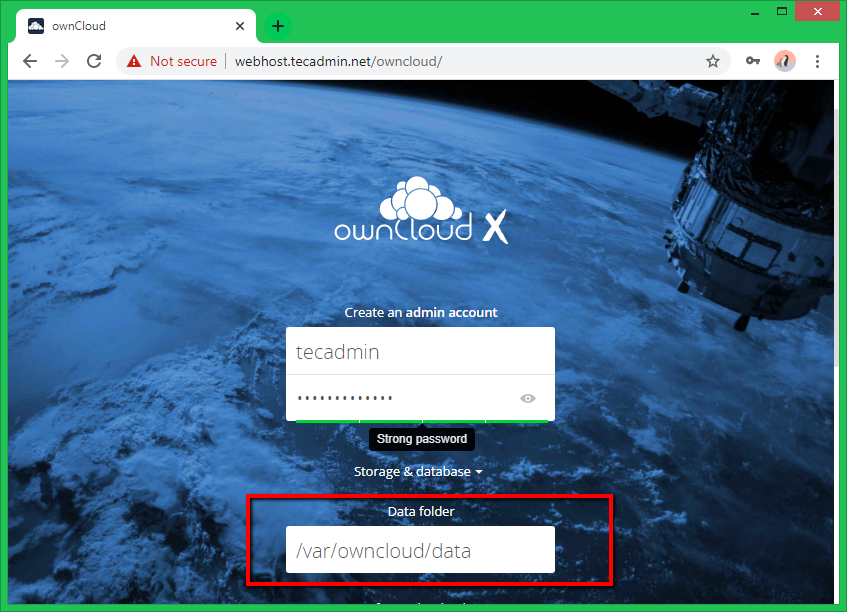
Now slide your page down and input the database credentials and click on Finish Setup.
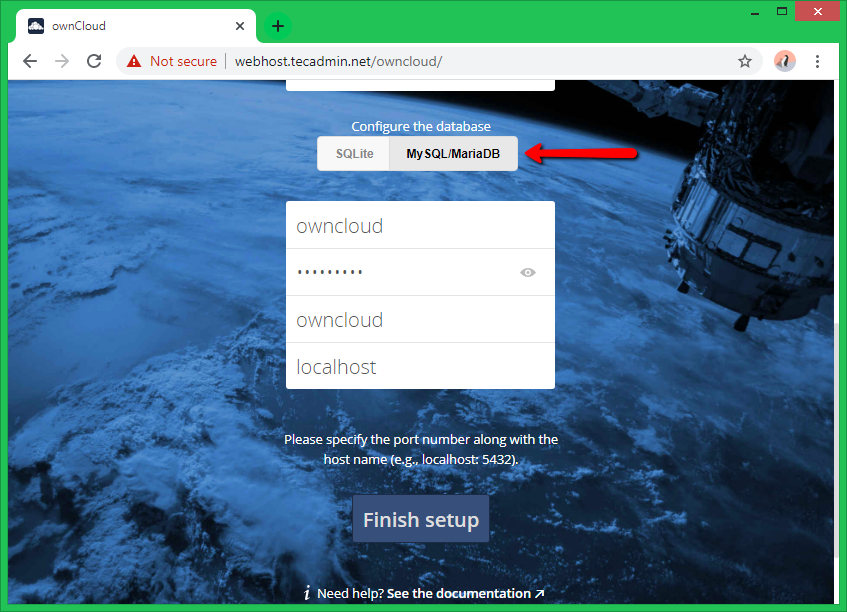
After completing the setup you will get the admin dashboard. Where you can create a user, and groups, assigned them permissions, etc.
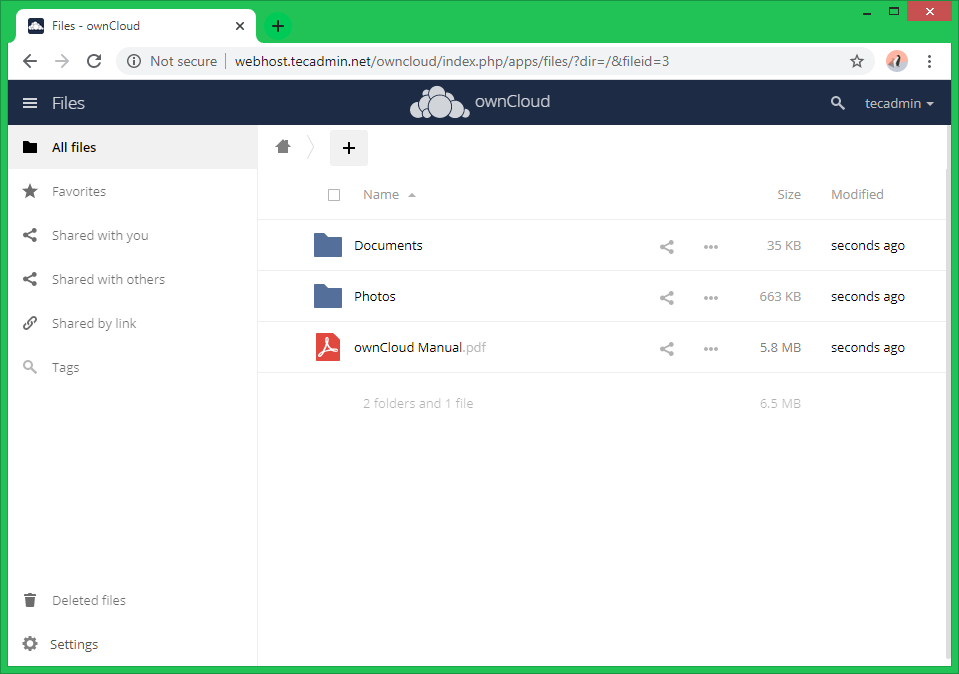
Congratulations! You have successfully installed ownCloud 10 on CentOS/RHEL 9/8. You can now start uploading and sharing files and data with your own personal cloud server.
Conclusion
In conclusion, installing ownCloud 10 on CentOS/RHEL 9/8 is a straightforward process that requires basic Linux administration skills. With ownCloud, you can have a secure and convenient way to store, share, and access your files and data from anywhere in the world.
============================
How to install OwnCloud on RHEL 8 / CentOS 8 server
In this article we will be performing an installation of OwnCloud directly from the official OwnCloud package. OwnCloud is a suite of client-server software to provide easy file sharing. The operating system to be used will be RHEL 8 / CentOS 8 server with MySQL, PHP and Apache web-server.
In this tutorial you will learn:
- How to install Owncloud prerequisites
- How to download and upzip OwnCloud source package
- How to setup MariaDB database
- How to setup OwnCloud
Software Requirements and Conventions Used
| Category | Requirements, Conventions or Software Version Used |
|---|---|
| System | RHEL 8 / CentOS 8/td> |
| Software | OwnCloud 10.0.10 or higher |
| Other | Privileged access to your Linux system as root or via the sudo command. |
| Conventions | # – requires given linux commands to be executed with root privileges either directly as a root user or by use of sudo command$ – requires given linux commands to be executed as a regular non-privileged user |
How to install OwnCloud on RHEL 8 / CentOS 8 server step by step instructions
- Install LAMP ( Linux, Apache, MariaDB and PHP ) server. Before you continue please follow our instructions on how to setup basic LAMP server on RHEL 8. Once ready move to the next step.
- Install all required OwnCloud prerequisites.
The following command will perform a package installation of all OwnCloud prerequisites in addition to the PHP packages already installed in
Step 1 :# dnf install php-mbstring php-gd php-pecl-zip php-xml php-json php-intl unzip
- Download and install OwnCloud.
Next step is to download a latest official OwnCloud Server source code package from the OwnCloud.org website. Perhaps the most convenient way to perform this task is by using the
wgetcommand. At the time of writing the latest OwnCloud version is 10.0.10. Update the below link if necessary:DOWNLOAD LATEST VERSION: $ wget https://download.owncloud.org/community/owncloud-10.0.10.zip
Once the package is downloaded execute the below linux commands to unzip the package into
/var/www/html, createdatadirectory and set appropriate directory permissions:# unzip owncloud-10.0.10.zip -d /var/www/html # mkdir /var/www/html/owncloud/data # chown -R apache:apache /var/www/html/owncloud/* # chcon -t httpd_sys_rw_content_t /var/www/html/owncloud/ -R
- Create MariaDB database to be used with OwnCloud.
The following commands will create MariaDB database named
owncloudand useradminwith passwordpass:# mysql -u root -p mysql> CREATE DATABASE owncloud; mysql> CREATE USER `admin`@`localhost` IDENTIFIED BY 'pass'; mysql> GRANT ALL ON owncloud.* TO `admin`@`localhost`; mysql> FLUSH PRIVILEGES; mysql> exit
- Start OwnCloud wizard and perform a final installation.
Navigate your browser to your servers URL and fill up the OwnCloud setup form:
WARNING
In case you see the below error message make sure that you have correctly installed all OwnCloud prerequisites as perStep 2 . Use the# php -m | grep -i PHP MODULE NAMEcommand to list if the required PHP module is available.ERROR 500: Internal Server Error.
- Your installation of OwnCloud on RHEL 8 / CentOS 8 should be now ready. Optionally install additional OwnCloud recommended PHP modules or secure your installation with
mod_ssl.
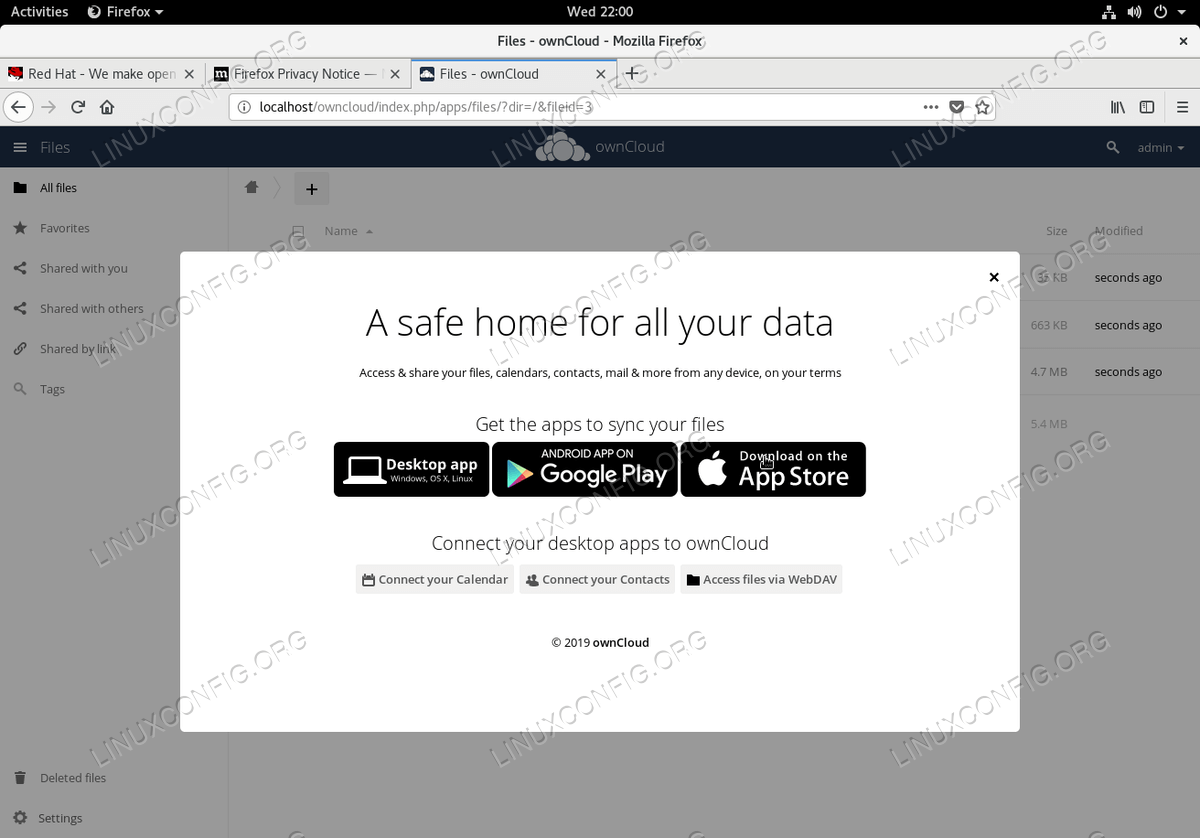
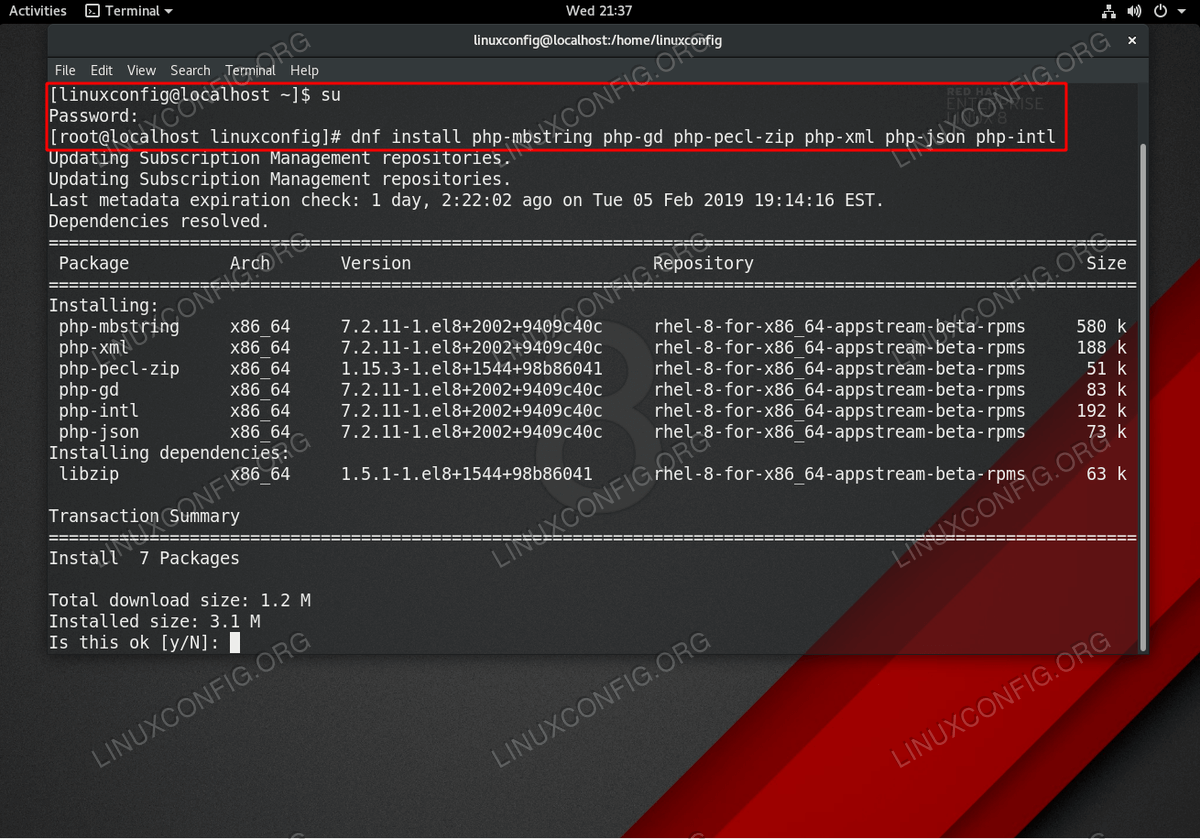
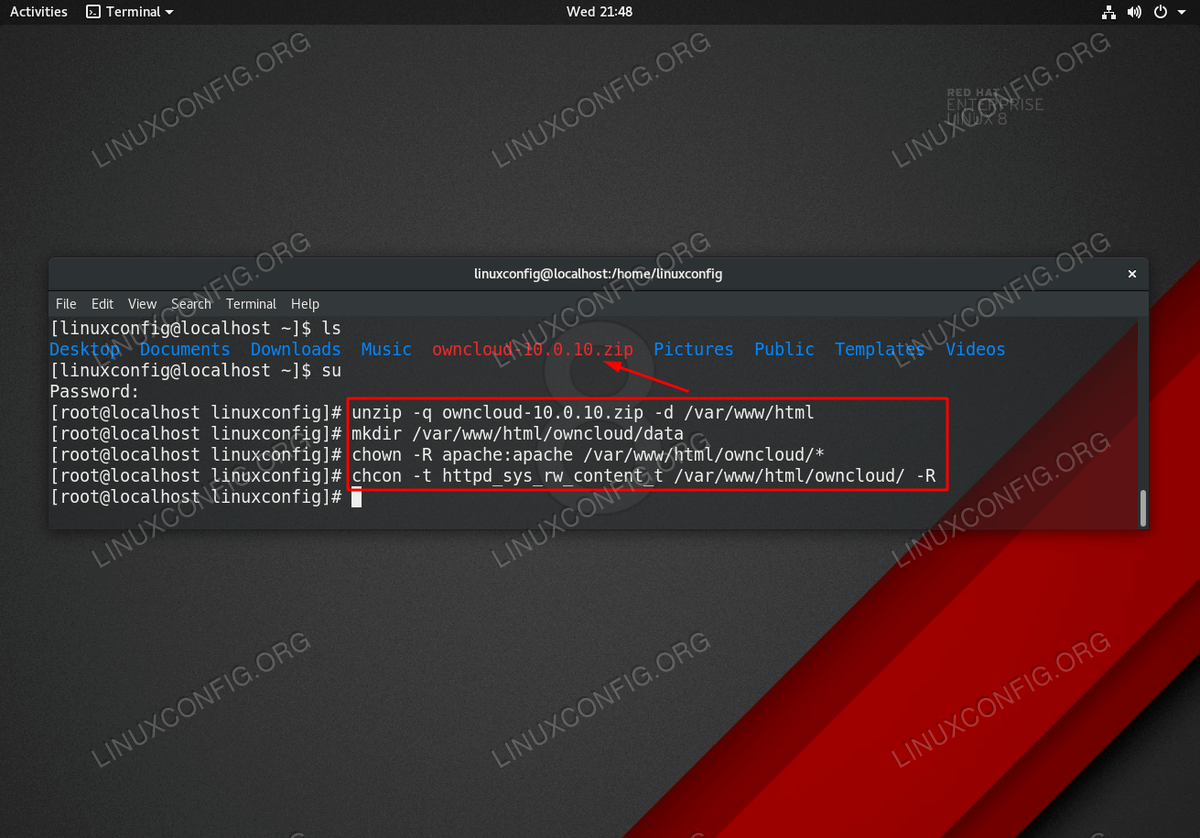


Tidak ada komentar:
Posting Komentar